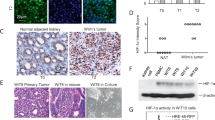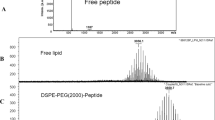Abstract
Transfection of the antiangiogenic angiostatin and endostatin genes was shown to be an alternative to high-dose administration of angiostatin or endostatin proteins for cancer therapy. We have systematically investigated whether coadministration of the mouse angiostatin kringle 1–3 gene (pFLAG-AngioK1/3) and the endostatin gene (pFLAG-Endo) complexed with cationic liposomes exhibits enhanced therapeutic efficacy. In vitro, the coexpressed mixture of angiostatin K1-3 and endostatin more effectively reduced angiogenesis in chorioallantoic membranes than either angiostatin K1-3 or endostatin alone. In vivo, subcutaneous co-administration of pFLAG-AngioK1/3 and pFLAG-Endo lipoplexes more effectively inhibited vascularization in Matrigel plugs implanted in mice than either one alone. Additionally, subcutaneous administration of these genes inhibited the growth and formation of pulmonary metastases of B16BL6 melanoma cells in mice. Compared to treatment with an empty vector, treatment with pFLAG-AngioK1/3 plus pFLAG-Endo inhibited 81% of tumor growth, while treatment with pFLAG-AngioK1/3 or pFLAG-Endo inhibited tumor growth 70 and 69%, respectively. Cotreatment with the two plasmids after primary tumor excision induced a 90% inhibition of pulmonary metastases versus 79% for pFLAG-AngioK1/3 or 80% for pFLAG-Endo individually. These results suggest that combined administration of angiostatin K1–3 and endostatin genes complexed with cationic liposomes may be an innovated antiangiogenic strategy for cancer therapy.
This is a preview of subscription content, access via your institution
Access options
Subscribe to this journal
Receive 12 print issues and online access
$259.00 per year
only $21.58 per issue
Buy this article
- Purchase on Springer Link
- Instant access to full article PDF
Prices may be subject to local taxes which are calculated during checkout






Similar content being viewed by others
References
Folkman J, Shing Y . Angiogenesis. J Biol Chem. 1992;267:10931–10934.
Kim KJ, Li B, Winner J, Gillett N, Phillips HS, Ferrara N . Inhibition of vascular endothelial growth factor-induced angiogenesis suppresses tumor growth in vivo. Nature. 1993;362:841–844.
Kandel J, Bossy-Wetzel E, Klagsbum M, Folkman J, Hanahan D . Neovascularization is associated with a switch to the export of bFGF in the multistep development of fibrosarcoma. Cell. 1991;66:1095–1104.
O’Relly MS, Holmgren L, Shin Y, et al. Angiostatin: a novel angiogenesis inhibitor that mediates the suppression of metastases by a Lewis lung carcinoma. Cell. 1994;79:315–328.
Rastinejad F, Polverini PJ, Bouck NP . Regulation of the activity of a new inhibitor of angiogenesis by a cancer suppressor gene. Cell. 1989;56:345–355.
Cao Y, Ji RW, Davidson D, et al. Kringle domains of human angiostatin. J Biol Chem. 1996;271:29461–29467.
O’Reilly MS, Boehm T, Shing Y, et al. Endostatin: an endogenous inhibitor of angiogenesis and tumor growth. Cell. 1997;88:277–285.
O’Relly MS, Holmgren L, Shin Y, Chen C, Folkman J . Angiostatin induces and sustains dormancy of human primary tumors in mice. Nat Med. 1996;2:689–692.
Yokoyama Y, Dhanabal M, Griffioen AW, Sukhatme VP, Ramakrishnan S . Synergy between angiostatin and endostatin: inhibition of ovarian cancer growth. Cancer Res. 2000;60:2190–2196.
Boehm T, Folkman J, Browder T, O’Reilly MS . Antiangiogenic therapy of experimental cancer dose not induce acquired drug resistance. Nature. 1997;390:404–407.
Sauter BV, Martinet O, Zhang WJ, Mandeli J, Woo Savio LC . Adenovirus-mediated gene transfer of endostatin in vivo results in high level of transgene expression and inhibition of tumor growth and metastases. Proc Natl Acad Sci USA. 2000;97:4802–4807.
Chen QR, Kumar D, Stass SA, Mixson AJ . Liposome complexed to plasmids encoding angiostatin and endostatin inhibit breast cancer in nude mice. Cancer Res. 1999;59:3308–3312.
Sacco MG, Caniatti M, Cato EM, et al. Liposome-delivered angiostatin strongly inhibits tumor growth and metastatization in a transgenic model of spontaneous breast cancer. Cancer Res. 2000;60:2660–2665.
Sambrook J, Fritsch EF, Maniatis T . Molecular Cloning: a Laboratory Manual. 2nd ed. New York, NY: Cold Spring Harbor Laboratory Press; 1989: 1.31–1.39.
Song YK, Liu F, Liu D . Characterization of cationic liposome-mediated gene transfer in vivo by intravenous administration. Hum Gene Ther. 1997;8:1585–1594.
Barron LG, Meyer KB, Szoka FC . Effects of complement deletion on the pharmacokinetics and gene delivery mediated by cationic lipid–DNA complexes. Hum Gene Ther. 1998;9:315–323.
Templeton NS, Lasic DD, Fredrik PM, Strey HH, Roberts DD, Pavlakis GN . Improved DNA:liposome complex for increased systemic delivery and gene expression. Nat Biotech. 1997;15:647–652.
Liu F, Song YK, Liu D . Hydrodynamics-based transfection in animals by systemic administration of plasmid DNA. Gene Therapy. 1999;6:1258–1266.
Kang IC, Lee YD, Kim DS . A novel disintegrin salmosin inhibits tumor angiogenesis. Cancer Res. 1999;59:3754–3760.
Passaniti A, Taylor RM, Pili R, et al. A simple, quantitative method for assessing angiogenesis and antiangiogenic agents using reconstituted basement membrane, heparin, and fibroblast growth factor. Lab Invest. 1992;67:519–528.
Weinder N . Intratumoral microvessel density as a prognostic factor in cancer. Am J Pathol. 1995;147:9–19.
Folkman J, Cole P, Zimmerman S . Tumor behavior in isolated perfused organs: in vitro growth and metastases of biopsy material in rabbit thyroid and canine intestinal segment. Ann Surg. 1996;164:491–502.
Fidler IJ, Ellis LM . The implications of angiogenesis for the biology and therapy of cancer metastasis. Cell. 1994;79:185–188.
Weinstar-Saslow D, Steeg PS . Angiogenesis and colonization in the tumor metastatic process: basic and applied advances. FASEB J. 1994;8:401–407.
Pluda JM . Tumor-associated angiogenesis: mechanisms, clinical implication, and therapeutic strategies. Semin Oncol. 1997;24:203–218.
Bicknell R, Harris AL . Anticancer strategies involving the vasculature: vascular targeting and the inhibition of angiogenesis. Semin Cancer Biol. 1992;3:399–407.
Scott PA, Harris AL . Current approaches to targeting cancer using antiangiogenesis therapies. Cancer Treat Rev. 1994;20:393–412.
Fan TP, Jagger R, Bicknell R . Controlling the vasculature: angiogenesis, anti-angiogenesis and vascular targeting of gene therapy. Trends Pharmacol Sci. 1995;16:57–66.
Wen XY, Bai Y, Stewart AK . Adenovirus-mediated human endostatin gene delivery demonstrate strain-specific antitumor activity and acute dose-dependent toxicity in mice. Hum Gene Ther. 2001;12:347–358.
Chesnoy S, Huang L . Enhanced cutaneous gene delivery following intradermal injection of naked DNA in a high ionic strength solution. Mol Ther. 2001;5:57–62.
Dhanabal M, Ramchandran R, Waterman MJ, Knebelmann B, Segal M, Sukhatme VP . Endostatin induces endothelial cell apoptosis. J. Biol. Chem. 1999;274:11721–11726.
Dixelius J, Larsson H, Sasaki T, et al. Endostatin-induced tyrosine kinase signaling through the Shb adaptor protein regulates endothelial cell apoptosis. Blood. 2000;95:3403–3411.
Moser TL, Stack MS, Asplin L, et al. Angiostatin binds ATP synthase on the surface of human endothelial cells. Proc. Natl. Acad. Sci. USA. 1999;96:2811–2816.
Griscelli F, Li H, Bennaceur-Griscelli A, et al. Angiostatin gene transfer: inhibition of tumor growth in vivo by blockage of endothelial cell proliferation associated with a mitosis arrest. Proc Natl Acad Sci USA. 1998;95:6367–6372.
Acknowledgements
We acknowledge the financial support of the Korea Ministry of Commerce, Industry, and Energy made in the program year of 2002 and the Maeji Academic Research Fund of Yonsei University, 2002.
Author information
Authors and Affiliations
Corresponding author
Rights and permissions
About this article
Cite this article
Kim, K., Kim, H., Park, J. et al. Inhibition of B16BL6 tumor progression by coadministration of recombinant angiostatin K1-3 and endostatin genes with cationic liposomes. Cancer Gene Ther 11, 441–449 (2004). https://doi.org/10.1038/sj.cgt.7700716
Received:
Published:
Issue Date:
DOI: https://doi.org/10.1038/sj.cgt.7700716
Keywords
This article is cited by
-
Targeted gene therapy of LS174 T human colon carcinoma by anti-TAG-72 immunoliposomes
Cancer Gene Therapy (2008)
-
Inhibition of angiogenesis and tumor progression by hydrodynamic cotransfection of angiostatin K1-3, endostatin, and saxatilin genes
Cancer Gene Therapy (2006)
-
Gene therapy for hepatocellular carcinoma using sonoporation enhanced by contrast agents
Cancer Gene Therapy (2005)
-
Angiogenesis in normal and neoplastic ovaries
Angiogenesis (2005)



